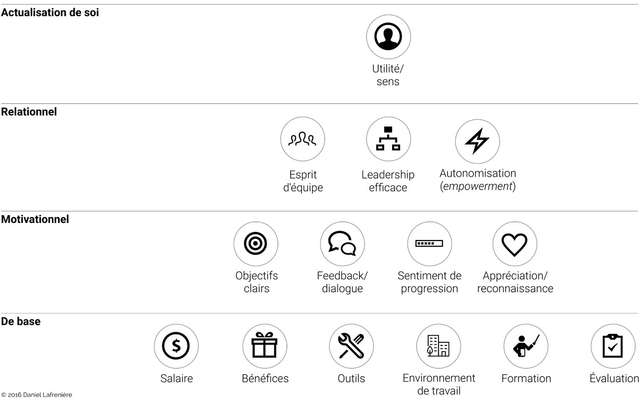A text from Soluflex
When was your last employee survey?
1 year? 1 month? Before the pandemic?
You may have noticed, but right now there's a big movement affectionately known as "the great resignation" (link to French text) that seems to be gaining in popularity.
In summary, according to a study conducted on the subject, more than 65% of Canadians are seriously considering leaving their current job.
Seriously considering!
I don't know about you, but personally I find this statistic extremely alarming.
WHY DO EMPLOYEES LEAVE THEIR WORK?
The work industry is in turmoil and employees have a lower tolerance for job-related dissatisfaction.
The main factors that encourage Canadians to change jobs are related to compensation, well-being and lack of career development.
But what about your business?
WHAT IS EMPLOYEE SATISFACTION?
Over the past few years, studies on the elements that influence employee satisfaction and engagement have come a long way.
Measuring employee satisfaction (or employee experience) is a complex project, so it is very easy to get lost. It is therefore essential to know which elements to measure in order to be effective and obtain a good return.
A few years ago, the excellent Daniel Lafrenière published an article in the newspaper Les Affaires (link to French text) highlighting the correlation between customer experience and employee experience.
From this article emerged a very powerful model which is based – in my opinion – on the theoretical concepts of Maslow and Herzberg.
Over time, this tool has become my tool of choice for any question relating to the employee experience, HR and management strategies.
French version only
So, these are the 13 elements to consider in your employee satisfaction measurement.
By basing our reflection on this model, I believe that the bases are solid enough to build a quality questionnaire.
WHY MEASURE THE SATISFACTION OF YOUR EMPLOYEES?
You have surely heard this saying: “happy employee = successful employee”.
Before launching an HR initiative, I strongly recommend that you survey your employees to obtain an overall picture of the situation and establish an action plan. This will allow to target the points of dissatisfaction for which there will be a real impact in the eyes of your collaborators.
HOW TO MEASURE EMPLOYEE SATISFACTION?
Easy, just ask them!
To obtain the information, you can rely on your HR statistics:
- High turnover = Low satisfaction
- High absenteeism = Low satisfaction
- Low quality = Low satisfaction
- Low ENPS = Low Satisfaction
On the other hand, you would only have an index of the level of satisfaction and/or commitment on the part of your employees.
To get a better understanding of the situation, ask the concerned parties. Today, in 2022, there is a range of more or less technological tools that will allow you to carry out this mandate.
Here are two (2) methods to effectively survey your employees:
1. ONE-TIME SURVEYS
If you want to use this method, I do not recommend that you use a premade questionnaire on the internet.
You are better off starting with a structured approach and on solid foundations, such as the employee experience pyramid presented above. For example, you could create one or more questions for each item.
To carry out this type of project, you could use tools like SurveyMonkey, Google Forms or the traditional paper survey and you would be very well served.
Advantages
One-time surveys allow you to take a snapshot of your current situation. They will give you an excellent starting point to establish an action plan and focus on the right variables to achieve maximum impact with your employees.
Disadvantages
Often onerous to administer, these surveys include many (too many?) questions and do not really allow us to obtain a real-time reading of the situation, which puts us in a reactive rather than proactive position.
2. CONTINUOUS SURVEY / IN REAL TIME
If you want to go further, you could use technological solutions like Amélio or Officevibe to measure your employees' satisfaction.
Their generic surveys are extremely powerful and well constructed. They allow you to measure the satisfaction of your employees according to 10 very specific criteria.
It is also possible to customize the questionnaires according to your reality and the specific aspects you wish to measure.
Advantages
The strength of these two (2) tools lies in their simplicity and consistency. They allow you to precisely follow the variations of satisfaction in real time and according to your business cycle.
Over time, you will be able to accumulate enough data to act in prevention rather than in reaction to a given situation.
Disadvantages
To fully use the features of the platform, this will require an annual budget.
However, as we saw earlier, companies that invest in employee satisfaction are much more profitable.
Then it's a matter of priorities!
PRO TIPS TO FINISH
Before leaving us, you should know one thing.
An extremely important thing.
Surveying employee satisfaction means creating expectations that must be carefully managed, at the risk of creating the opposite effect.
The key in this case: Communication! Say what you're going to do, and do what you say. Remember, throughout the process, to preserve the anonymity of your respondents.
There you have it; you have everything in hand to start (or relaunch) your approach to surveying the satisfaction of your employees.
Remember that employee satisfaction is at the heart of your HR strategies!
Our HR experts have everything they need to help you survey your employees. Do you want to know more about the survey that Soluflex offers? Just click here! (French link)
Mathieu St-Amant
President and HR Consultant
Soluflex Estrie






